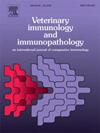评价聚合抗原BLSOmp31在新型笼状颗粒佐剂(ISPA卵黄)中配制,经肠外或粘膜给药对公羊布鲁氏菌的疗效
IF 1.4
3区 农林科学
Q4 IMMUNOLOGY
引用次数: 0
摘要
鸡布鲁氏菌(B. ovis)是绵羊传染性附睾炎的病原,是全世界鸡群生殖障碍的主要原因。虽然减毒后的melitensis Rev.1菌株对该病原体具有异源保护作用,但它有重要的缺点。亚单位疫苗可以提供一种更安全的替代方案,考虑到“同一个健康”的做法。聚合体BLSOmp31先前被确定为对抗该病原体的保护性免疫原。在我们之前对BALB/c小鼠的研究中,我们评估了一种名为ISPA的新型笼状颗粒佐剂中配制的BLSOmp31的性能。在本研究中,我们使用了一种新的低成本ISPA变体ISPA蛋黄(BLSOmp31/ISPA蛋黄)配制的BLSOmp31。该制剂通过皮下和眼路给予公羊。我们评估了全身和粘膜免疫反应,并评估了其对鹅双球菌的保护能力。两种途径给药BLSOmp31/ISPA蛋黄均可诱导全身和可变粘膜IgG和IgA抗体应答,对血清学诊断无干扰。此外,该配方诱导了显著的特异性细胞免疫反应,并增加了外周血单核细胞中具有混合Th1/Th2谱的细胞因子基因的相对表达水平。虽然该疫苗不能预防实验感染B. ovis,但与通过眼路接种和未接种的公羊相比,经肠外免疫的公羊感染器官较少,生殖器官的组织病理学改变也较轻。相比之下,该制剂,无论是通过SC还是CONJ途径给药,都可以减少通过精液消除卵巢双球菌,并将感染传播的风险降至最低。本文章由计算机程序翻译,如有差异,请以英文原文为准。
Evaluation of the efficacy of polymeric antigen BLSOmp31 formulated in a new cage-like particle adjuvant (ISPA YOLK) administered by parenteral or mucosal routes against Brucella ovis in rams
Brucella ovis (B. ovis) is the etiological agent of ram-contagious epididymitis, the leading cause of reproductive disorders in flocks worldwide. Although the attenuated B. melitensis Rev.1 strain gives heterologous protection against this pathogen, it has important disadvantages. Subunit vaccines could provide a safer alternative that considers the One Health approach. Polymeric BLSOmp31 was previously identified as a protective immunogen against this pathogen. In our previous work in BALB/c mice, we evaluated the performance of BLSOmp31 formulated in a new cage-like particle adjuvant called ISPA. In the present study, we administered BLSOmp31, which was formulated in a new low-cost variant of ISPA called ISPA YOLK (BLSOmp31/ISPA YOLK). This formulation was given to rams through both subcutaneous and ocular routes. We evaluated the systemic and mucosal immune responses and assessed its protective capacity against B. ovis. BLSOmp31/ISPA YOLK administered by both routes induced systemic and variable mucosal IgG and IgA antibody response, without interference in the serological diagnosis. Additionally, this formulation induced significant specific cellular immune responses and an increase in the relative expression levels of cytokine genes in peripheral blood mononuclear cells with a mixed Th1/Th2 profile. While this vaccine did not prevent experimental infection with B. ovis, parenterally immunized rams had fewer infected organs and less severe histopathological changes in reproductive organs compared to animals vaccinated by ocular route and non-immunized rams. In contrast, this formulation, whether administered by SC or CONJ route could reduce the elimination of B. ovis through semen, and minimize the risk of spreading the infection.
求助全文
通过发布文献求助,成功后即可免费获取论文全文。
去求助
来源期刊
CiteScore
3.40
自引率
5.60%
发文量
79
审稿时长
70 days
期刊介绍:
The journal reports basic, comparative and clinical immunology as they pertain to the animal species designated here: livestock, poultry, and fish species that are major food animals and companion animals such as cats, dogs, horses and camels, and wildlife species that act as reservoirs for food, companion or human infectious diseases, or as models for human disease.
Rodent models of infectious diseases that are of importance in the animal species indicated above,when the disease requires a level of containment that is not readily available for larger animal experimentation (ABSL3), will be considered. Papers on rabbits, lizards, guinea pigs, badgers, armadillos, elephants, antelope, and buffalo will be reviewed if the research advances our fundamental understanding of immunology, or if they act as a reservoir of infectious disease for the primary animal species designated above, or for humans. Manuscripts employing other species will be reviewed if justified as fitting into the categories above.
The following topics are appropriate: biology of cells and mechanisms of the immune system, immunochemistry, immunodeficiencies, immunodiagnosis, immunogenetics, immunopathology, immunology of infectious disease and tumors, immunoprophylaxis including vaccine development and delivery, immunological aspects of pregnancy including passive immunity, autoimmuity, neuroimmunology, and transplanatation immunology. Manuscripts that describe new genes and development of tools such as monoclonal antibodies are also of interest when part of a larger biological study. Studies employing extracts or constituents (plant extracts, feed additives or microbiome) must be sufficiently defined to be reproduced in other laboratories and also provide evidence for possible mechanisms and not simply show an effect on the immune system.

 求助内容:
求助内容: 应助结果提醒方式:
应助结果提醒方式:


